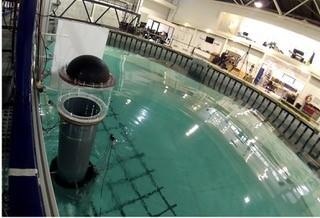Feb 13 2019
A device based on wave energy technology costs less than conventional designs, has fewer moving parts, and is built with durable materials. It is designed to be combined into present-day ocean energy systems and can change wave power into electricity. Small scale experiments in an ocean simulator reveal that one full-size device could produce the equivalent of 500 kW, sufficient electricity for nearly 100 homes. Engineers say that their design could be employed in fleets of economical, easily maintained structures at sea within a few decades, to exploit the power of waves in the Scottish waters.
 Scale trials are held in the FloWave facility at the University of Edinburgh of a wave energy converter device that could provide power to thousands of homes. (CREDIT: Universities of Trento, Bologna and Edinburgh and Scuola Superiore Sant'Anna Pisa)
Scale trials are held in the FloWave facility at the University of Edinburgh of a wave energy converter device that could provide power to thousands of homes. (CREDIT: Universities of Trento, Bologna and Edinburgh and Scuola Superiore Sant'Anna Pisa)
Flexible membranes
Using flexible rubber membranes, engineers from the University of Edinburgh and from Italy designed their device known as a Dielectric Elastomer Generator (DEG). It is engineered to fit on top of a vertical tube which, when put in the sea, partially fills with water that rises and falls according to the motion of the waves.
When waves pass the tube, the water within forces trapped air above to inflate and deflate the generator on top of the device. As the membrane inflates, a voltage is produced. This increases as the membrane deflates, and electricity is generated. In a commercial device, this electricity would be conveyed to the shore using underwater cables.
Water tests
A scaled-down model of the system was tested in the FloWave facility at the University of Edinburgh, a 25 m diameter circular tank that can replicate any combination of ocean waves and currents. The system could substitute conventional designs containing complex air turbines and costly moving parts.
The research, reported in Proceedings of the Royal Society A, was performed in partnership with the Universities of Trento, Bologna and Scuola Superiore Sant'Anna Pisa in Italy. It was aided by the European Union Horizon 2020 programme and Wave Energy Scotland.
Wave energy is a potentially valuable resource around Scotland’s coastline, and developing systems that harness this could play a valuable role in producing clean energy for future generations.
David Ingram, Professor, School of Engineering, University of Edinburgh..